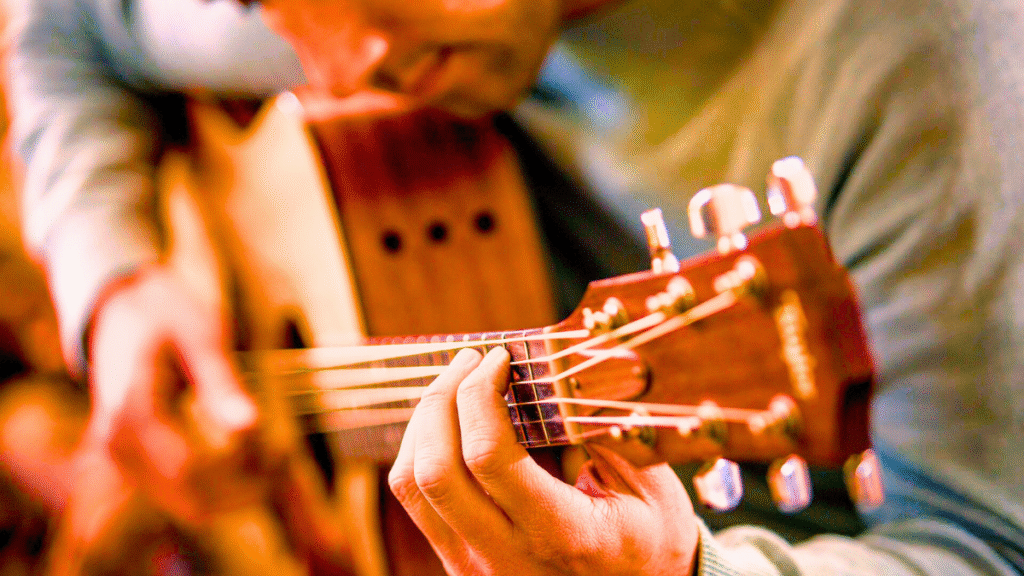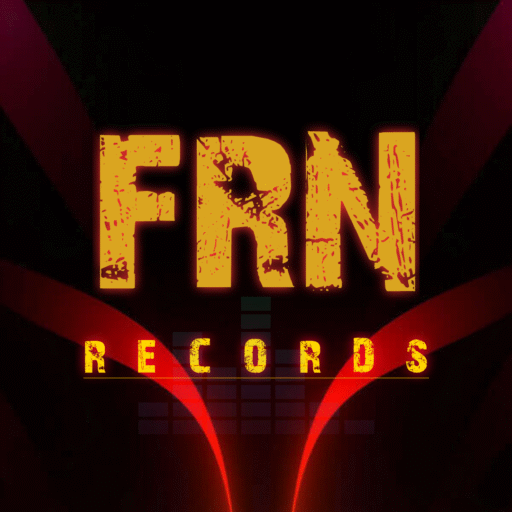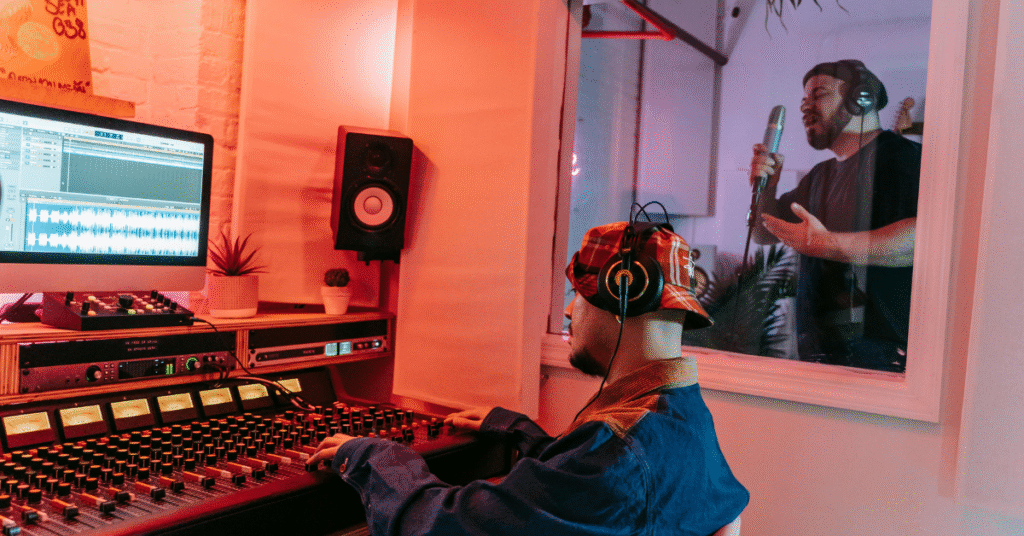How to Play Guitar: The Complete Beginner’s Guide
Affiliate Disclosure
This post contains affiliate links. We may receive a commission if you buy through our links.
Make your practice smoother—choose beginner-friendly tools that actually work like guitar & chords book.

Have you ever asked yourself, “How do I play guitar?” or “How can I learn guitar easily?” You’re not alone. Whether you want to play your favorite songs, jam with friends, or become a professional guitarist, learning how to play guitar is one of the most rewarding musical journeys you can take.
In this complete guide, you’ll learn step-by-step how to play guitar — starting from the absolute basics. Whether you’re a beginner or just picking it up again after years, this is your one-stop manual for mastering the instrument.
Why Learn How to Play Guitar?
Learning how to play guitar can do more than just help you make music. It boosts creativity, relieves stress, improves memory, and helps you connect with people.
And the best part? Anyone can do it. Yes, even if you’ve never held a guitar before.
Step 1: Choose the Right Guitar
Before you can learn how to play guitar, you need to choose the right type for your needs.
- Acoustic Guitar
Perfect for beginners. It doesn’t require an amplifier and is great for learning chords and finger strength.
The acoustic guitar is a universal instrument so you can definitely buy one at the beginning
- Electric Guitar
Easier to press strings, perfect for rock and blues. Needs an amplifier.
You Can Cheak Here Electric Guitar.
- Classical Guitar
Has nylon strings and is great for fingerstyle and softer tones.
Classical guitars are also used in industry
Tip: Start with an acoustic if you’re unsure. It builds a solid foundation.
Step 2: Understand Guitar Anatomy
Before you dive in, it helps to understand the basic parts of your guitar:
- Headstock – Holds the tuning pegs
- Neck – Where you press down strings
- Frets – Metal strips across the neck
- Body – The large part of the guitar that produces sound
- Strings – Typically six, numbered 1 (thinnest) to 6 (thickest)
Knowing your instrument well helps you follow lessons more effectively.
Step 3: How to Hold a Guitar Correctly
If you’re wondering “How do we play guitar comfortably?”, posture is everything.
- Sit on a chair (no armrests)
- Rest the body of the guitar on your right thigh (if right-handed)
- Use your left hand to hold the neck
- Keep your back straight
Comfort leads to better practice.
Step 4: Learn Basic Guitar Chords
Chords are groups of notes that sound good together. Most songs are built from just a few simple chords.
Beginner Chords to Start With:
- C Major
- G Major
- D Major
- A Minor
- E Minor
These chords are the foundation of most pop, rock, and folk songs.
How do you play chords on a guitar?
Place your fingers on the correct frets and strum all (or some) of the strings. Practice each chord until it sounds clean with no buzzing.
Step 5: Master Basic Strumming Patterns
Strumming brings your chords to life. Start with simple patterns:
- Down Down Down Down
- Down Up Down Up
- Down Down Up Up Down Up
Play slowly at first and stay consistent with your rhythm. Use a metronome to help you stay in time.
Step 6: Learn How to Read Guitar Tabs
One of the most important beginner skills is learning how to read tab guitar notation.
Tabs are an easy way to learn songs without needing to read traditional music.
Example:
lua
CopyEdit
e|—–0—–
B|—–1—–
G|—–0—–
D|—–2—–
A|—–3—–
E|———–
This means: play the 3rd fret on the A string, 2nd on the D, 0 (open) on G, 1st on B, and open high E.
Tabs let you learn songs visually and quickly, making them perfect for beginners.
Step 7: Practice Simple Songs
Now that you know some chords and how to read tabs, it’s time to play actual songs!
Easy Songs to Start With:
- “Horse With No Name” – Two chords
- “Knockin’ on Heaven’s Door” – G, D, Am, C
- “Stand By Me” – G, Em, C, D
Practice these slowly, one line at a time. Playing real music boosts confidence and motivation.
Step 8: Understand Finger Placement and Technique
Good technique prevents bad habits later. Here’s how to get it right:
- Press strings with your fingertips
- Keep your thumb behind the neck, not over it
- Don’t let your fingers mute nearby strings
- Practice slowly and cleanly
Step 9: Learn Guitar Scales (Optional for Beginners)
Once you’re comfortable with chords and strumming, scales can help you understand melody and soloing.
Start with:
- Major Scale
- Minor Pentatonic Scale
- Blues Scale
These are especially useful if you’re interested in lead guitar.
Step 10: Take Lessons or Follow a Learning Path
There are many options depending on your learning style:
Free Online Lessons:
- YouTube channels like JustinGuitar, Marty Music, or GuitarZero2Hero
Paid Courses:
- Fender Play, Guitar Tricks, Yousician
These platforms offer structured paths and instant feedback — ideal if you’re serious about mastering the guitar.
Step 11: Stay Consistent With Practice
Consistency beats long, irregular sessions. Try this schedule:
- 15–20 mins/day for beginners
- Focus on 1 chord + 1 strumming pattern each day
- Review what you learned at the end of the week
Keep a notebook or app to track your progress.
FAQs About Learning Guitar
Q1. How do you play a guitar as a complete beginner?
Ans: Start with learning open chords, basic strumming, and simple songs. Don’t rush—start slow and build your skill.
Q2. How do I play guitar without a teacher?
Ans: Use free online resources or beginner-friendly courses. Consistent practice and video tutorials can guide you well.
Q3. How can I play guitar faster?
Ans: Break it into small goals, repeat them daily, and focus on clean transitions between chords.
Q4. How to play guitar for beginners without reading music?
Ans: Use guitar tabs and chord charts. They’re visual and super easy to understand — no music theory required.
Q5. What’s the best way to learn how to play guitar chords?
Ans: Start with open chords like C, G, and D. Use diagrams, practice slow, and repeat often until they become muscle memory.
Final Thoughts: Anyone Can Learn How to Play Guitar
The journey of learning guitar starts with a simple step — picking up the instrument. Whether you’re using YouTube, taking lessons, or following your ear, the key is consistency and enjoyment.
From understanding how to read tab guitar to playing full songs and mastering chords, each small win builds up to real skill.
So if you’re still asking, “How do you play guitar?”, the answer is simple: you start today, and you keep going.
Happy playing — your guitar journey begins now!
What song are you trying to play? Let us know in comments!
Need help with chords or strumming? Ask freely—we’re here!
Hi, I’m Nikhil Farenjiya, a music producer and professional singer with 10 years of experience. I share my knowledge and passion for music through writing to help aspiring artists grow. My blog is dedicated to inspiring and guiding music lovers on their creative journey.


